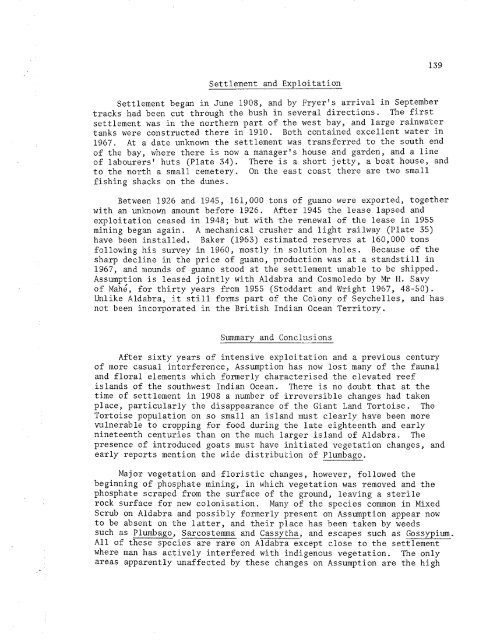ATOLL RESEARCH BULLETIN - Smithsonian Institution
ATOLL RESEARCH BULLETIN - Smithsonian Institution
ATOLL RESEARCH BULLETIN - Smithsonian Institution
You also want an ePaper? Increase the reach of your titles
YUMPU automatically turns print PDFs into web optimized ePapers that Google loves.
Settlement and Exploitation<br />
Settlement began in June 1908, and by Fryer's arrival in September<br />
tracks had been cut through the bush in several directions. The first<br />
settlement was in the northern part of the west bay, and large rainwater<br />
tanks were constructed there in 1910. Both contained excellent water in<br />
1967. At a date unknown the settlement was transferred to the south end<br />
of the bay, where there is now a manager's house and garden, and a line<br />
of labourers' huts (Plate 34). There is a short jetty, a boat house, and<br />
to the north a small cemetery. On the east coast there are two small<br />
fishing shacks on the dunes.<br />
Between 1926 and 1945, 161,000 tons of guano were exported, together<br />
with an unknown amount before 1926. After 1945 the lease lapsed and<br />
exploitation ceased in 1948; but with the renewal of the lease in 1955<br />
mining began again. A mechanical crusher and light railway (Plate 35)<br />
have been installed. Baker (1963) estimated reserves at 160,000 tons<br />
following his survey in 1960, mostly in solution holes. Because of the<br />
sharp decline in the price of guano, production was at a standstill in<br />
1967, and mounds of guano stood at the settlement unable to be shipped.<br />
Assumption is leased jointly with Aldabra and Cosmoledo by Mr H. Savy<br />
of ~ah;, for thirty years from 1955 (Stoddart and Wright 1967, 48-50).<br />
Unlike Aldabra, it still forms part of the Colony of Seychelles, and has<br />
not been incorporated in the British Indian Ocean Territory.<br />
Summary and Conclusions<br />
After sixty years of intensive exploitation and a previous century<br />
of more casual interference, Assumption has now lost many of the faunal<br />
and floral elements which formerly characterised the elevated reef<br />
islands of the southwest Indian Ocean. There is no doubt that at the<br />
time of settlement in 1908 a number of irreversible changes had taken<br />
place, particularly the disappearance of the Giant Land Tortoise. The<br />
Tortoise population on so small an island must clearly have been more<br />
vulnerable to cropping for food during the late eighteenth and early<br />
nineteenth centuries than on the much larger island of Aldabra. The<br />
presence of introduced goats must have initiated vegetation changes, and<br />
early reports mention the wide distribu'iion of Plumbago.<br />
Major vegetation and floristic changes, however, followed the<br />
beginning of phosphate mining, in which vegetation was removed and the<br />
phosphate scraped from the surface of the ground, leaving a sterile<br />
rock surface for new colonisation. Many of the species common in Mixed<br />
Scrub on Aldabra and possibly formerly present on Assumption appear now<br />
to be absent on the latter, and their place has been taken by weeds<br />
such as Plumbago, Sarcostemma and Cassy.tha, and escapes such as Gossypim.<br />
All of these species are rare on Aldabra except close to the settlement<br />
where man has actively interfered with indigenous vegetation. The only<br />
areas apparently unaffected by these changes on Assumption are the high

















